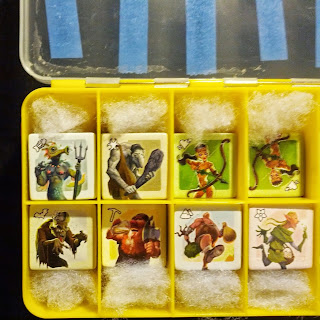Introduction
So I've mentioned Midnight Party a few times now in recent posts. This game was very much a kid's game (supports ages 4 and up) from 1989. It was designed by Wolfgang Kramer, who years later would create several games of greater popularity (like El Grande, The Princes of Florence, Torres, Colosseum, Category 5, and his Mask Trilogy of games). |
| The box (above) and rules were destroyed by water. You can see some of the damage on the upper part of the box. |
 |
| Early sketch, just playing around. [Instagram] |
The pieces that were still good were:
- Hugo the Ghost
- Ghost die (d6 with 1, 2, 4, 5 and 2 Ghost faces replacing the 3 and 6)
- 30 Guests
- 6 Blue and Red (for a 2+ player game)
- 5 Turquoise (for a 3+ player game)
- 4 Yellow (for a 4+ player game)
- 3 Black (for a 5+ player game)
- 2 Purple, Green, White (for a 6-8 player game)
Design
The only thing I really need to rework is the game board. The problem is that I really want this to be as visually captivating of a game as I can make it. In order to do this I started taking one approach, and then started along a secondary one. Neither are finished yet, but I think enough process has been hashed out to at least start talking about these designs. I plan to complete both designs in the future. |
| I took general and detailed pictures of the board to try and capture as much detail as possible. (The upper left part was in pretty bad shape though) |
 |
| Game board with some measurements and added notes. |
 |
| Some board/box sketches. above: assembled, below: separated. |
I sketched out some ideas on how to accomplish this kind of presentation and eventually came up with the idea on the right. Pretty much the idea is to try and have a shallow box for pieces to keep the cellar from being so steep that pieces can't stay on the tilt.
 I got some wood and additional components from Home Depot and then went to Michael's for some Acrylic paint to paint the boards with. I figured since this painting part would probably take the most time, I should start looking into getting a heads start on it. I chose acrylic paint because I knew it would provide bold colors and dry quickly, but it had also been at least a decade since I cracked open acrylic paint.
I got some wood and additional components from Home Depot and then went to Michael's for some Acrylic paint to paint the boards with. I figured since this painting part would probably take the most time, I should start looking into getting a heads start on it. I chose acrylic paint because I knew it would provide bold colors and dry quickly, but it had also been at least a decade since I cracked open acrylic paint.Revelation
I was looking at some canvases to practice painting with acrylics on and then it hit me: For some games, I could paint the boards on canvas and store them as such. It was a fascinating idea - the board as art and the pieces stored behind the canvas. I'm sure some of the inspiration came from getting CO2 recently (the watercolor look is beautifully striking), but I think a majority of the idea game from Solarquest. Up until this point I was considering learning how to make my own [typical] game board (this still may occur), but the idea of working tirelessly on painting a board that would just get stored in a box seemed a little demoralizing.I picked up a 10"x20" canvas and got started on another game board for Midnight Party testing this idea out (I used Midnight Party because its board is both smaller and more difficult than the Solarquest board - pretty sure I can paint planets). Here are the results after each round of painting so far:
 |
| Round 1 (Basic layout) |
 |
| Round 2 (Early text and detail) |
While not yet complete, I think these can kinda show how I'm thinking this could work. Furthermore I think if I can add something that would allow pieces/rules to be stored behind the canvas (without much increase in weight), this may be a really neat way to present games to people. "Hey, you want to play chess? Here, let me pull it off the wall for you."
 |
| Game pieces on canvas. See an unnecessary autoawesomed version of this at the bottom of this, courtesy of Google+ . |
Conclusion
So initially I had one board idea and game out with two. My intention at this point is to complete the canvas version in the near future and look at a Solarquest board next (unless something else catches my eye more). On the side, I'm hoping to construct my initial box and board design, although I know there's more construction involved in this one.Bonus: Unnecessary Autoawesome
Google+ has an effect called "Autoawesome" that gets applied to a sequence of similar pictures taken over a short timeframe. While I find them distracting to the post, it's kinda fun to see what they do. So here you go.
 |
| I guess it's a good way to see that these pieces do, in fact, have three dimensions. |
 |
| It was hypnotic enough that I felt the need to add it in. |































